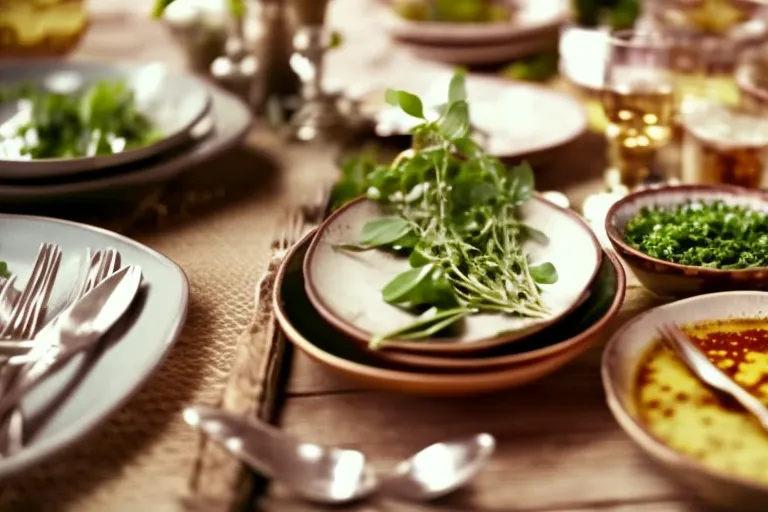If you're a foodie, you've probably heard of Georgian cuisine. Known for its bold flavors, hearty dishes, and abundant use of herbs and spices, Georgian food is a feast for the senses. But what is the history behind this delicious cuisine? In this article, we'll take a closer look at the origins of Georgian food and explore some of its most iconic dishes.
The Land of Plenty
Georgia, located in the Caucasus region of Eurasia, has a long and rich culinary history. The country's unique geography and climate have played a significant role in shaping its cuisine. With a mild coastal climate in the west and a more continental climate in the east, Georgia is home to a wide variety of fruits, vegetables, and grains. The country's fertile soil and abundant water sources have also made it an ideal place for raising livestock, which has been a staple of Georgian cuisine for centuries.
The Georgian cuisine is characterized by the use of fresh ingredients, fruits, and vegetables that are grown locally. The country is known for its fertile soil and ideal climate that is perfect for growing a variety of vegetables, fruits, and herbs. The most common ingredients used in Georgian cuisine include eggplants, tomatoes, cucumbers, peppers, beans, and mushrooms.
The Influence of the Silk Road
Georgia's location at the crossroads of Europe and Asia has also had a significant impact on its cuisine. The ancient Silk Road, which connected China to the Mediterranean, passed through Georgia, bringing with it a wealth of spices, herbs, and other culinary ingredients. Over time, these ingredients became an integral part of Georgian cuisine, giving it a unique flavor profile that is distinct from other regional cuisines.
The Silk Road was a major trade route that connected the East and the West, and Georgia was a crucial point on this route. The traders and travelers who passed through Georgia brought with them a variety of spices, herbs, and other culinary ingredients that were not available locally. These ingredients were incorporated into Georgian cuisine, giving it a unique flavor that is still appreciated today.
The Role of Hospitality
Another key aspect of Georgian food culture is the importance of hospitality. Georgian people are known for their warm and welcoming nature, and this is reflected in the way they approach food. In Georgian culture, food is not just about sustenance, but also about bringing people together and creating a sense of community. This is why Georgian meals are often served family-style, with large platters of food shared among everyone at the table.
Hospitality is an integral part of Georgian culture, and food plays a central role in this. Georgian people are known for their warm and welcoming nature, and they take great pride in their culinary traditions. When guests arrive, they are greeted with a feast that includes a variety of dishes, including meat, vegetables, and bread. The host will often go out of their way to ensure that their guests are well-fed and satisfied.
Iconic Georgian Dishes
So, what are some of the most iconic dishes in Georgian cuisine? Here are a few examples:
-
Khachapuri: This cheese-filled bread is one of the most beloved dishes in Georgia. There are many different variations of khachapuri, but the most common is a boat-shaped bread filled with a mixture of cheese, eggs, and butter.
-
Khinkali: These dumplings are a staple of Georgian cuisine and are often filled with a mixture of meat and spices. They are typically served with a sprinkle of black pepper and a side of sour cream.
-
Satsivi: This rich, creamy sauce is made with ground walnuts, garlic, and spices, and is often served with chicken or turkey.
-
Badrijani: These eggplant rolls are filled with a mixture of ground walnuts, garlic, and spices, and are often served as an appetizer.
-
Mtsvadi: This is a traditional Georgian barbecue made with marinated chunks of meat that are grilled over an open flame. It is often served with a side of vegetables and bread.
-
Lobio: This is a hearty bean stew that is made with red beans, onions, garlic, and a variety of spices. It is often served with a side of bread and is a staple of Georgian cuisine.
The Future of Georgian Food
While Georgian cuisine has a long and storied history, it is also evolving with the times. In recent years, Georgian chefs have been experimenting with new techniques and ingredients, while still staying true to the country's culinary traditions. This has led to the emergence of a new wave of Georgian cuisine, which is gaining popularity both in Georgia and around the world.
One of the most exciting trends in Georgian cuisine is the use of modern cooking techniques and ingredients. Many Georgian chefs are experimenting with sous vide cooking, molecular gastronomy, and other cutting-edge techniques to create new and innovative dishes. They are also incorporating new ingredients, such as quinoa, kale, and other superfoods, into traditional Georgian dishes.
Conclusion
In conclusion, Georgian food is a fascinating and delicious cuisine with a rich history and many iconic dishes. Whether you're a foodie looking to explore new flavors or simply curious about the culinary traditions of Georgia, there is much to discover in this vibrant and flavorful cuisine. So why not try making a khachapuri or khinkali at home and experience the magic of Georgian food for yourself?
